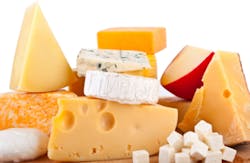Cheesemaking: Examining the effects of microbial contamination
In the newly released March issue of Water Technology, Ramsey Kropp, Ph.D., chief scientist of AquaMost Inc., writes about how microbial contamination can affect the food and beverage industry, specifically during cheesemaking. In this article, Kropp discusses microbial contamination of food and beverage products and how it is a “potentially catastrophic occurrence,” resulting in food spoilage or foodborne illness.
Food production and distribution are tightly regulated, explains Kropp, however, in the U.S. there is little secondary inspection of these products, so foodborne illness outbreaks are typically only detected after consumers become sick. “An outbreak can lead to costly product recalls, regulatory fines, negative consumer sentiment, loss of brand value, idling production facilities and civil or potentially criminal legal proceedings,” adds Kropp.
Yet in most cases, microbes, found in almost every known environment, pose no risk or are beneficial, and many are needed in the preparation of foods and beverages, says Kropp, noting that some of the best microbiologists in the world are in the baking, brewing and cheesemaking industries.
“Prevention of foodborne illness or food spoilage requires carefully balanced microbial control through removing harmful bacteria from production equipment and process ingredient streams, while not adversely affecting good quality or preventing the growth of desired microbes,” reports Kropp.
In general, he continues, harmful microbes can be categorized into four groups: Protists, viruses, bacteria and fungi, with bacteria and fungi posing the largest threats for cheese production since they are mainly responsible for foodborne illness and spoilage. Even with strict control measures in place, many cheesemaking plants will have some level of microbial contamination, as microbes often elude detection and inactivation.
Kropp asserts that a well-designed and “rigorously applied” hygiene plan is required in order to safeguard “low-level, natural microbial background” from reaching levels impacting safety and/or quality. Additionally, procedures for microbial control must identify risks of contamination from every potential source and take the necessary steps to prevent contamination from occurring.
For the food, beverage and dairy industries, microbes of concern are found in three broad “environments”: On surfaces, in the ambient air or atmosphere, and in water, states Kropp.
Microbial water treatment
“Water is an integral component in cheese production as an ingredient, as the working fluid in heating and cooling operations, for cleaning equipment, and for rinsing products and packages,” says Kropp. “Microbial contamination in water has the potential to affect the final product at multiple points, so particular care is warranted.”
According to Kropp, common microbial water treatment technologies include:
- Chemical treatment: Regularly used for municipal treatment since it provides a long-lasting residual disinfection
- Thermal treatment: Oldest disinfection technology and historically the most widely used technique
- Ultraviolet (UV) irradiation: Commonly used to inactivate microbes by damaging the DNA upon exposure to UV light, particularly UV-C light
- Membrane processes: Can be highly effective for providing “microbially pure water”
- Advanced oxidative processes (AOPs): Consists of several novel treatment methods relying on the generation of hydroxyl radicals and other radical species capable of destroying cellular structures and breaking down organic chemicals.
You can find the March feature on microbial contamination in cheesemaking here.
